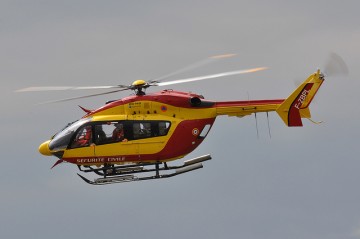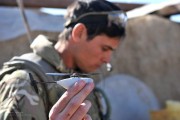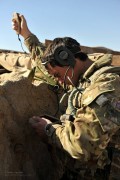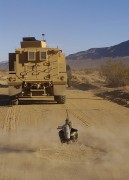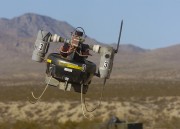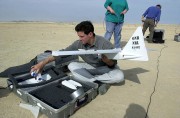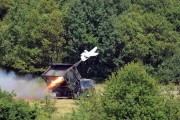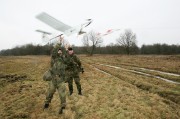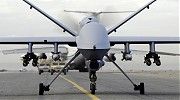Weitere Unterabschnitte: Aktuelle Technik | Landstreitkräfte | Luftwaffe | Marine | Roboter und Drohnen | Satellitengestützte Strukturen | Cyberwar | Historisches
Roboter und Drohnen
Defence Images – Flickr
- Soldier Operating Black Hornet Nano UAV Helicopter
- Soldier Operating Black Hornet Nano UAV Helicopter (2)
- Soldier Operating Black Hornet Nano UAV Helicopter (3)
Marion Doss – Flickr
- A Micro Air Vehicle (MAV) takes off
- A Micro Air Vehicle (MAV) flies over a simulated combat area
Class I UAV Block 0
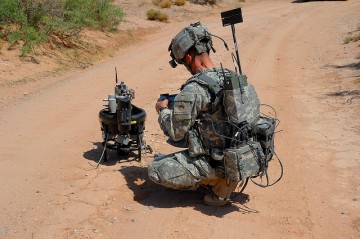
First UK Flight of Watchkeeper UAV
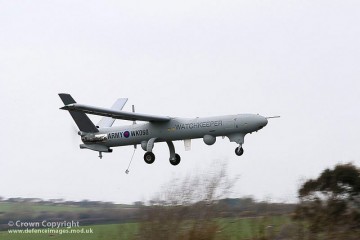
25.04.12 Unbemannte Flugzeuge erobern das Schlachtfeld und verändern radikal das Kriegshandwerk. Welche Fähigkeiten werden die intelligenten Kampfmaschinen haben, und was bedeuten sie für die internationale Politik?
12.02.2002 Die Höhe der Opfer des "genauesten Kriegs" aller Zeiten ist noch nicht bekannt, wohl aber lässt sich ein bedenklicher Trend künftiger Infowars erkennen
20.04.2012 Wie anscheinend auch in Pakistan, will die CIA nicht gezielt hochrangige Militante töten, sondern Angriffe auf Ziele führen, wo "verdächtiges Verhalten" beobachtet wurde
How drone works
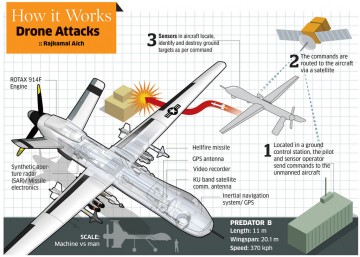
17.02.2011 Während des Forums Unmanned Vehicles III der Deutschen Gesellschaft für Wehrtechnik in Bonn-Bad Godesberg standen die Erfahrungen der Bundeswehr mit dem unbemannten Flugsystem Heron-1 im Vordergrund. Dabei wurde deutlich: Auf Dauer werden die Militärroboter nicht unbewaffnet bleiben.
Marion Doss – Flickr
- Installing batteries that power the UAV
- Navigating the Unmanned Air Vehicle (UAV)
Cyborg insects
30.12.2011 Nur rund 20 Millimeter groß ist der grün leuchtende Mistkäfer, aus dem US-Forscher der Uni Michigan einen schwirrenden Spion und Lebensretter machen wollen.
Energy Scavenging – YouTube
26.11.2011 The latest buzz on insects is that they could be implanted with devices like tiny cameras, microphones and gas sensors – to go places humans can’t.
Global Hawk, NASA’s New Remote-Controlled Plane
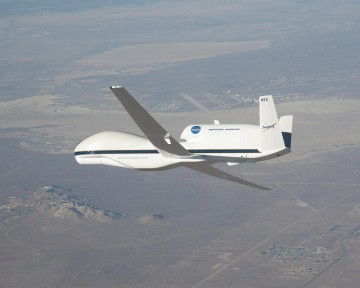
Bundeswehr-Fotos – Flickr
- Start einer Drohne
- Drohne ALADIN
Verseuchte Air-Force-Rechner: US-Drohnenlenker kämpfen mit Virenbefall – SPIEGEL ONLINE – Nachrichten – Netzwelt
Bei den Drohnenangriffen in Pakistan handelt es sich um eine seit 2004 vom CIA durchgeführte Kampagne im Rahmen des Kriegs gegen den Terror. Dabei greifen Drohnen Ziele in Pakistan an. Vor allem die Stammesgebiete unter Bundesverwaltung sind davon betroffen. Die Einsätze unterstehen strikter Geheimhaltung seitens der Vereinigten Staaten. Erst am 30. Januar 2012 bestätigte der US-amerikanische Präsident Barack Obama die Angriffe offiziell.
Drohnen-Piloten sitzen weit weg von den Zielen, die sie anvisieren. Sie steuern die unbemannten Flugkörper per Joystick und Monitor mit großer Präzision und zu einem Bruchteil der Kosten, die ein Kampfjet verursacht.

